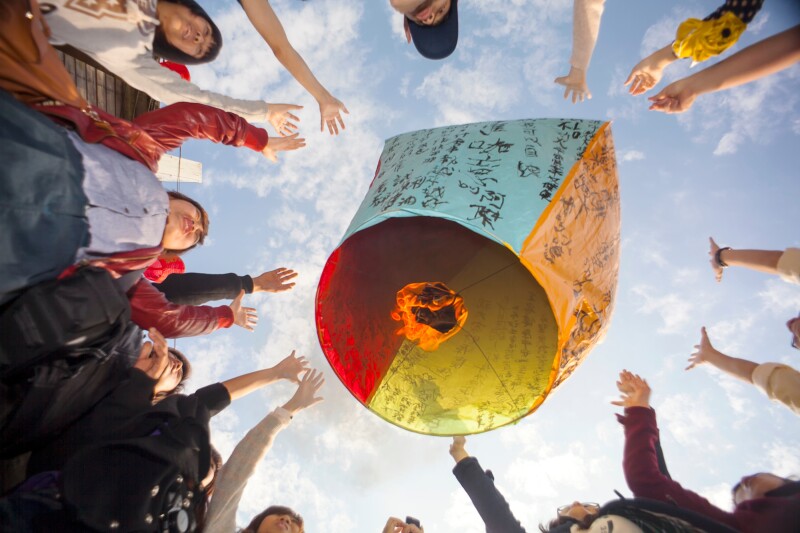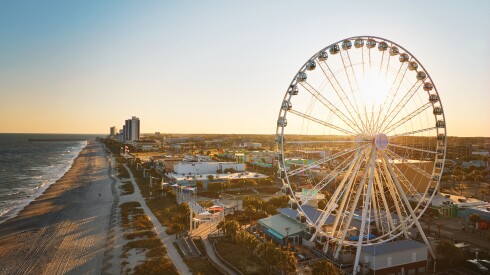Lanterns have been used for centuries throughout countries in Asia to commemorate cultural and spiritual celebrations. Sky lanterns can be traced back thousands of years to the Eastern Han Dynasty in China (25–220 C.E.) when the objects were used not only as decorative light sources but also as military signals that could communicate messages across long distances.
Historians believe that the first organized lantern festivals also emerged during the Han Dynasty, though no one is certain when or how they came about. One theory points to Buddhist monks, who would light lanterns on the 15th day of the holiday to honor Buddha—an act that evolved into a way for families to pay tribute to ancestors. Another more fanciful origin story goes that the Jade Emperor (a principal figure in Chinese mythology) threatened to burn down a village after its citizens accidentally killed his favorite pet crane. His daughter took pity on the townsfolk and instructed them to trick the Emperor into thinking their homes were already on fire by lighting lanterns and setting off fireworks—the plan worked and sparked a ritual that continued year after year.
Across the centuries, the tradition of lantern festivals spread around the world—from a floating lantern festival in Hawai‘i to Vietnam’s monthly full moon festival.

In Hội An, the Full Moon Lantern Festival is celebrated on the 14th day of each lunar month when the moon is at its fullest and brightest.
Photo by Kobby Dagan/Shutterstock
1. Full Moon Lantern Festival
- Where: Hội An, Vietnam
- When: Hội An’s Full Moon Lantern Festival falls on November 3 and December 3, 2025, and January 2, February 1, March 2, April 1, May 30, June 28, July 27, August 26, September 24, October 23, November 22, and December 22 in 2026.
Held on the 14th day of each lunar month, Hội An’s Full Moon Lantern Festival transforms the UNESCO-listed Old Town into a river of flickering light. In Buddhist tradition, the full moon is considered an ideal time to meditate, reflect, observe rituals, and honor deceased ancestors.
At sundown, homes and businesses across the city turn off their electric lights, leaving the streets lit almost entirely by silk-covered lanterns hung from balconies and strung across alleyways. Vendors set up along the Thu Bồn River selling paper lanterns with small candles inside, and both locals and travelers place them on the water with a wish for good fortune, health, or happiness.

Chinese lanterns are traditionally red, as the color is believed to symbolize warmth, happiness, and good fortune.
Photo by Toa55/Shutterstock
2. Spring Lantern Festival
- Where: Hong Kong and Mainland China
- When: March 3, 2026
The annual Spring Lantern Festival—also called Yuan Xiao Festival—officially closes out Chinese New Year. It’s a holiday that is centered on family reunions, community gatherings, and welcoming the arrival of spring. Although specific customs vary regionally across the Chinese-speaking world, the most prevalent activities involve lighting lanterns, guessing riddles, eating tangyuan (glutinous rice balls with fillings like sweet red beans or black sesame paste), and watching traditional lion dance performances.

Taiwan’s Pingxi Lantern Festival occurs annually in the rural Pingxi District in New Taipei.
Photo by Shutterstock
In Hong Kong, the two biggest events are both in Tsim Sha Tsui, Kowloon—one outside the Hong Kong Cultural Centre and the other along the West Kowloon Waterfront Promenade. China’s largest Spring Lantern Festival celebration takes place near the main Confucius temple in Nanjing, the capital of the eastern Jiangsu province, but events are held in other cities such as Shanghai and Beijing, as well as in rural regions.
3. Pingxi Lantern Festival
- Where: Pingxi District, Taiwan
- When: March 3, 2026
About an hour by train from Taipei, the mountain towns of Pingxi transform into one of the most photogenic lantern celebrations in the world. Marking the first full moon of every Lunar New Year—normally during February or March—lantern releases are held in rural villages of the Pingxi District, including Jingtong, Nanshan, and Shifen, where the largest event takes place.
During the festival, thousands of people gather to scribble their wishes or prayers directly onto colorful paper lanterns with ink brushes before lighting a small flame inside. As the heat fills the lantern, it floats upward along with hundreds of others, creating a steady stream of glowing lights rising above the hills. The release of the lanterns, which also commemorates the official end of Chinese New Year, is considered a symbolic release of past worries and a hopeful gesture toward the year ahead.

The Shinnyo Lantern Floating Hawai‘i ceremony brings thousands of O‘ahu residents and visitors together each year on Memorial Day.
Photo by ChristopherMYa/Shutterstock
4. Shinnyo Lantern Floating Hawai‘i
- Where: O‘ahu, Hawai‘i
- When: TBD for 2026, but it is usually scheduled around Memorial Day
Every Memorial Day on O‘ahu, thousands of people gather at Ala Moana Beach for Shinnyo Lantern Floating Hawai‘i, to honor and remember their deceased loved ones. Organized by the Shinnyo-en Buddhist community, the event draws residents and travelers alike, many arriving hours early to secure a spot along the shoreline. The ceremony begins with a series of traditional performances by local musical groups and hula practitioners, followed by a prayer led by the head of the Shinnyo-en community, Her Holiness Shinso Ito.
As the sun begins to set, participants send hand-decorated floating lanterns meant to inspire remembrance, hope, and good fortune into the Pacific Ocean. (The Buddhist community retrieves the lanterns from the Pacific afterward, cleans and repairs them, and stores them for use in future festivals.) Dates for the 2026 celebration have yet to be determined, but the 2025 festival was on Monday, May 29.

In Buddhist culture, releasing a floating lantern into the sky represents optimism and new beginnings.
Photo by PanatFoto/Shutterstock
5. Yi Peng Festival
- Where: Chiang Mai, Thailand
- When: November 5–6, 2025 and November 24–25, 2026
Yi Peng is one of Thailand’s most iconic lantern festivals, observed primarily in the northern regions but best known for the mass lantern release outside Chiang Mai. The ceremony involves releasing rice paper lanterns—called khom loy—into the sky as an offering to the Buddha. According to local belief, sending a lantern upward helps cleanse a person’s spirit and eases their misfortunes, clearing the path for good luck in the coming year.
While the ritual was historically reserved for monks, it has expanded into a highly photographed public celebration that draws international travelers to the event, which occurs on the day of the full moon during the second month of the Lanna lunar calendar (12th month of the Thai lunar calendar). Entry requires purchasing highly coveted tickets, most of which are sold through authorized tourism agencies and start from around $145 up to $475. Often the tickets sell out months in advance. Outside the ticketed events, smaller, more local gatherings take place around the city.

Loi Krathong celebrations, which coincide with the Yi Peng Festival in northern Thailand, take place more broadly across Thailand.
Photo by Shutterstock
6. Loi Krathong
- Where: Across Thailand
- When: November 6, 2025 and November 25, 2026
Loi Krathong takes place the same full moon night as the Yi Peng Festival, and while the two festivals are often mentioned together, they involve distinctly different traditions. Both annual events are considered “festivals of light,” but Loi Krathong involves releasing a krathong (a basket traditionally made out of banana leaves and stocked with candles and incense) into rivers, lakes, or canals as opposed to sending lanterns floating into the sky.
Loi Krathong lasts for one night on the full moon of the 12th month of the traditional Thai calendar. The most popular celebrations take place in Bangkok and Sukhothai, but travelers in Chiang Mai for the Yi Peng Festival will also be able to observe Loi Krathong events.

The Nagasaki Lantern Festival is held to celebrate the Lunar New Year.
Courtesy of Ken Funakoshi/Flickr
7. Nagasaki Lantern Festival
- Where: Nagasaki, Japan
- When: February 6–23, 2026
Held over the first 15 days of Lunar New Year to mark the beginning of spring, the Nagasaki Lantern Festival is believed to have been started by Chinese immigrants and became an official Nagasaki holiday in 1994. The festival is held in the city’s Chinatown, the oldest in Japan because Nagasaki was the only port open to foreign traders during the Heian and Edo periods.
In addition to seeing a fantastic display of more than 15,000 lanterns strung above the streets and across canal bridges, attendees can also expect Chinese lion and dragon dances, an Emperor’s parade, and even acrobatic shows. Street food stalls pop up along the main routes, offering both classic Japanese street food staples like yaki imo (roasted sweet potatoes) and takoyaki (bite-size pieces of octopus cooked in a savory batter) and Chinese-style snacks, such as mooncakes.

The Jokhang Temple in Lhasa is a Tibetan spiritual hub that plays host to the annual Butter Lantern Festival.
Photo by Moroz Nataliya/Shutterstock
8. The Butter Lantern Festival
- Where: Lhasa, Tibet
- When: March 4, 2026
Every year, the deliciously named Butter Lantern Festival marks the final and most festive day of the Monlam, or Tibetan New Year. While the religious holiday is rooted in prayer and reflection, it’s also a time for feasting on dishes like khapse (fried pastries), chang (barley wine), and dresil (sweet rice with yak butter). During the celebrations, locals spend days crafting elaborate sculptures from colored yak butter, shaping them into flowers, deities, and mythical creatures.
These creations are displayed outdoors alongside lanterns fueled by clarified yak butter. The act of creating these items is considered a form of prayer. Festivities take place all over Tibet, but one of the liveliest places to celebrate is in the capital city of Lhasa around Barkhor Street and in front of the Jokhang Temple (one of the country’s most spiritually important places), where lanterns and butter sculptures are featured. Expect dancing, singing, and even puppet shows.
This article was originally published in 2019 and most recently updated on October 17, 2025 with current information. Mae Hamilton and Sarah Buder contributed to the reporting of this story.











